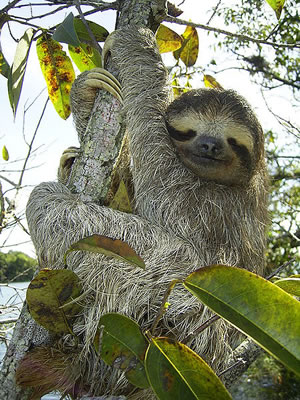The animals that live in the tropical rainforest canopy have adaptations that allow them to cling to and grasp trees.
Sloth
Sloths use their hooklike claws to cling to branches. They have little or no tails.
They get their name from the fact that they never move fast-a mother sloth was observed to travel at a speed of 15 feet an hour when hurrying toward her baby.
 Their lack of speed helps to protect sloths from predators. Jaguars and harpy eagles, both of which would prey on sloths if given the chance, do not notice them.
Their lack of speed helps to protect sloths from predators. Jaguars and harpy eagles, both of which would prey on sloths if given the chance, do not notice them.
There are six types of sloth-four have three digits on each hand and foot, and two have just two digits-all found only in the tropical rainforests of Central America and Amazonia.
Adults are about 2 feet (60cm) long and weigh 9 to 16 pounds (4 to 7kg).
The sloth's body temperature fluctuates with that of their surroundings to a marked degree. This feature is thought to be primitive, pointing to their ancient origin.
Most of their relatives, the giant ground sloths of the Tertiary, became extinct quite recently, and only the specialized sloths, anteaters and armadillos survive today as three tips of a once enormous iceberg.
The sloth's three-inch long claws function primarily as hooks to allow the animal to spend much of its time hanging upside-down from the branches of trees. The claws are also useful for pulling down twigs of Cecropia and spondias so the sloth can feed on the leaves.
The three-toed sloth feeds mainly on these two plants, which makes it a difficult animal to keep in captivity.
However, the two-toed sloth eats the leaves and fruits of a wide range of plants. Surprisingly, the sloth can wield its claws as weapons with considerable speed and skill if roused.
Forest tribesmen do not often hunt the sloth, partly because of the injuries it can inflict, but also because a sloth does not drop to the ground when wounded or killed. The claws continue to cling by reflex action and it seems that a dead sloth will only drop to the ground when decomposition of its body is quite advanced.
Sloths spend almost all their lives up in the canopy, but once a week the three-toed sloth, genus Bradypus, descends to the base of its tree to defecate. Using its stumplike tail as an auger, the sloth digs a shallow hole into which it drops its stool. After covering it, the sloth climbs back up into the canopy
Two-toed sloths, genus Choloepus, defecate while hanging on branches, and tend to use the same spot each time. On the ground, a sloth cannot stand properly or walk, but lies with all four limbs sprawled out helplessly. On a flat surface, it can use its strong claws to drag the body slowly forward.
Sloths are excellent swimmers and move well in the rivers of the tropical rainforest.
Females give birth while they hang in the trees. They give birth to one infant at a time.
Once it is born, the new baby, which is about one-twentieth of its mother's weight, crawls up the mother's abdomen with the help of its well-developed claws.
For about two months, it stays concealed in the shaggy fur and feeds on its mother's milk. After about five or six months the young sloth leaves its mother and wanders off to start its own life. Female sloths breed for the first time when they are about two years of age.
The sloth is usually found upside-down. It never moves more than one limb at a time. The three-toed sloth has nine neck vertebrae-two more than is usual for mammals- which allows it great flexibility when turning its head.
Silky Anteater
The silky, or pygmy, anteater is related to the sloth. The silky anteater, Cyclopes didactylus, can be found from Mexico to Trinidad, Brazil and Peru.
The silky anteater, like the sloth, moves slowly and sluggishly.
It is well adapted for life in the trees, with a strong prehensile tail from which it can suspend its whole body, and knifelike claws the tear through the tough nests of tree termites with great efficiency.
The silky anteater uses its claws to defend itself from predators.
Baby silky anteaters ride on their mother's backs.
Like its cousins the giant anteater and the tamandua, the silky anteater is specialized for sucking up ants and termites, and has no teeth. Instead, it has a long sticky tongue and a muscular gizzard in the stomach to grind up insects.
Although silky anteaters are sometimes active during the day, they are generally nocturnal and find most of their food at night.